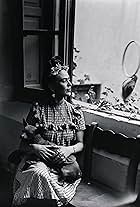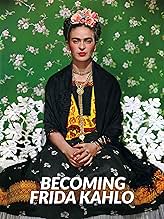Frida Kahlo(1907-1954)
- Additional Crew
Magdalena Carmen Frieda Kahlo y Calderon was born on July 6, 1907 in Mexico City, Mexico. She was the
seventh daughter of Guillermo Kahlo (born Carl Wilhelm Kahlo), a successful German photographer who emigrated to
Mexico from Pforzheim, and of a mestiza mother, Matilde Calderón y González. Her father encouraged her interest
in art, photography and archaeology; her mother was not so well
educated, and also very religious.
At the age of 6, Frida suffered an attack of poliomyelitis, which left her with a deformed leg, although exercise and determination helped her to make a good recovery. At 14, she enrolled into one of Mexico's best schools hoping to forge a career in medicine; however, on September 17, 1925, she suffered serious injury in a traffic accident in Mexico City, breaking her spinal column and pelvis in three places, as well as her collar bone and two ribs. Her right leg, already deformed by polio, was shattered and fractured in 11 places and her right foot was dislocated. Frida spent the next month in hospital, and another 2 months at home recuperating, followed by 32 operations during her life-time. Her first prolonged hospitalization gave her the opportunity to rethink her life and become a painter, in spite of constant pain and discomfort.
She met her future husband, painter Diego Rivera, when he painted a mural at her school in 1923; they re-met in 1927 and began an affair. Although her mother objected to Frida dating Diego mostly because of their age differences (he was exactly 20 years older) and their awkward appearance together (she was 5' 3" tall and weighed only 100 lbs, he was 6' and weighed nearly 300 lbs), they were married in a traditional Catholic civil ceremony in 1929.
Melancholia, illness, separation, divorce, and re-marriage marked their relationship; Diego Rivera was a womanizer and their marriage was stormy. Frustrated by his philandering, Frida (a closet lesbian/bisexual) had affairs with both men and women, including a fling with exiled Russian revolutionary Lev Trotskiy in 1938. Her career as an artist was highly successful and took her around Mexico, New York and Europe.
Frida and Diego divorced early in 1940, and soon after, Frida's health deteriorated. Her moderate to heavy drinking, chain-smoking, and a steady diet of candy exacerbated her infirmity. In the early 1930s, she developed an atrophic ulcer on her right foot, from which several gangrenous toes were amputated in 1934.
Frida and Diego Rivera reconciled and were re-married on his 54th birthday, in December 1940, in San Francisco, California. Following the amputation of her right leg in 1953, Frida became a recluse and more deeply depressed, finally losing the will to live. She was found dead at home in Mexico City on July 13, 1954, allegedly from kidney, liver and heart failure, although some believe she committed suicide by taking an overdose of pills.
At the age of 6, Frida suffered an attack of poliomyelitis, which left her with a deformed leg, although exercise and determination helped her to make a good recovery. At 14, she enrolled into one of Mexico's best schools hoping to forge a career in medicine; however, on September 17, 1925, she suffered serious injury in a traffic accident in Mexico City, breaking her spinal column and pelvis in three places, as well as her collar bone and two ribs. Her right leg, already deformed by polio, was shattered and fractured in 11 places and her right foot was dislocated. Frida spent the next month in hospital, and another 2 months at home recuperating, followed by 32 operations during her life-time. Her first prolonged hospitalization gave her the opportunity to rethink her life and become a painter, in spite of constant pain and discomfort.
She met her future husband, painter Diego Rivera, when he painted a mural at her school in 1923; they re-met in 1927 and began an affair. Although her mother objected to Frida dating Diego mostly because of their age differences (he was exactly 20 years older) and their awkward appearance together (she was 5' 3" tall and weighed only 100 lbs, he was 6' and weighed nearly 300 lbs), they were married in a traditional Catholic civil ceremony in 1929.
Melancholia, illness, separation, divorce, and re-marriage marked their relationship; Diego Rivera was a womanizer and their marriage was stormy. Frustrated by his philandering, Frida (a closet lesbian/bisexual) had affairs with both men and women, including a fling with exiled Russian revolutionary Lev Trotskiy in 1938. Her career as an artist was highly successful and took her around Mexico, New York and Europe.
Frida and Diego divorced early in 1940, and soon after, Frida's health deteriorated. Her moderate to heavy drinking, chain-smoking, and a steady diet of candy exacerbated her infirmity. In the early 1930s, she developed an atrophic ulcer on her right foot, from which several gangrenous toes were amputated in 1934.
Frida and Diego Rivera reconciled and were re-married on his 54th birthday, in December 1940, in San Francisco, California. Following the amputation of her right leg in 1953, Frida became a recluse and more deeply depressed, finally losing the will to live. She was found dead at home in Mexico City on July 13, 1954, allegedly from kidney, liver and heart failure, although some believe she committed suicide by taking an overdose of pills.






